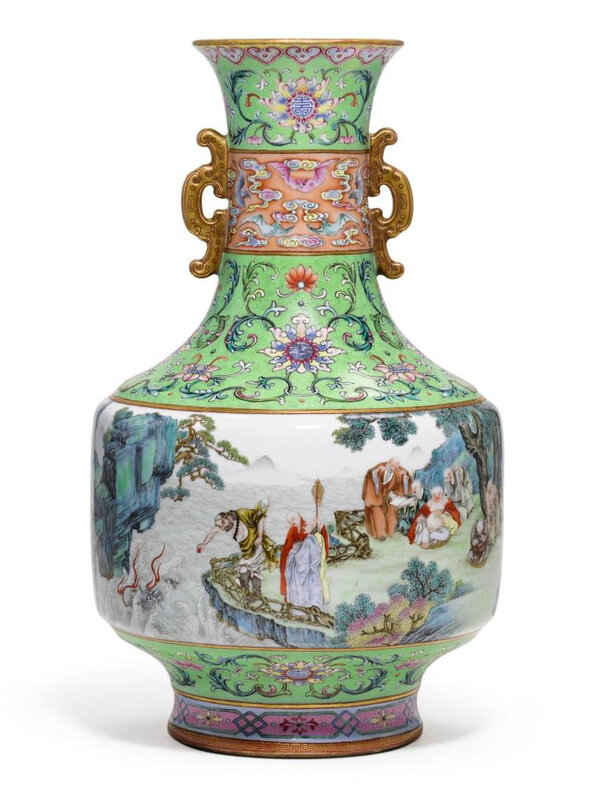An Imperial 'famille rose' 'Eighteen Luohan' vase , Qing dynasty, Qianlong period (1736-1795)
Lot 17. An Imperial 'famille rose' 'Eighteen Luohan' vase , Qing dynasty, Qianlong period (1736-1795); 37.2 cm, 14 1/2 in. Estimate 100,000 — 200,000 GBP. Lot Sold 657,000 GBP. Courtesy Sotheby's 2018.
well potted with a wide cylindrical body rising from a short spreading foot to a tall slender waisted neck with a flared rim, the neck flanked by a pair of archaistic iron-red and gilt C- shaped handles, the body finely enamelled with a continuous scene of the Eighteen Luohan within a rocky landscape, the neck and foot similarly decorated with leafy lotus strapwork reserved on a lime green feather scroll ground, the neck further collared by a bat and cloud salmon pink band below the mouth, the interior glazed in turquoise.
Note: Exceptionally rare for the delicately painted scene of the eighteen luohan engaged in various activities in an idealised landscape, this vase demonstrates not only the accomplished brushwork of the artisans but also their ability to conceive the finished overall product even before beginning to throw the vessel on the wheel. No other closely related example appears to have been published, although a very similar vase, but painted with a landscape, from the collection of Mr and Mrs Isaac D. Fletcher and now in the Metropolitan Museum, New York, is published in Denise Patry Leidy, How to Read Chinese Ceramics, New York, 2015, pl. 39. Individual elements of both shape and decoration are well known, evidence of the Qianlong potters’ masterful ability at combining their many stylistic elements in myriad ways to create ever new designs.
The legacy of Tang Ying (1682-1756), the brilliant Superintendent of the Imperial kilns at Jingdezhen from the Yongzheng to early Qianlong reigns, is evident in the landscape setting on the present vase. A gifted painter himself, scenes signed with his seal, either painted directly by him onto the vessel or transferred from his ink paintings by professional porcelain decorators, have survived from the early Qianlong period. This landscape design was further adapted to incorporate figures, as seen on the present vase, and its combination with a formal scroll against a coloured ground identifies it as representative of a later stage of porcelain decoration in the Qianlong reign. The green-ground neck and foot with formal floral scrolls have been painted in simulation of work characteristic of yangcai porcelains, which were likely inspired by brocade designs.
Only one other pair of vases of this sumptuous form and design, with Qianlong seal marks and of the period, but painted with a similarly rendered mountainous scene filled with large pavilions and thatched homes against pink enamel borders also embellished with further a dense feather scroll ground, from J.T. Tai & Co., was sold in our Hong Kong rooms, 7th October 2010, lot 2130.
From J.T. Tai & Co. A superb pair of pink-ground famille-rose 'Landscape' vases, seal marks and of the period of Qianlong (1736-1795); 36.5 cm., 14 3/8 in. Sold for 99,220,000 HKD at Sotheby's Hong Kong, 7th October 2010, lot 2130. Courtesy Sotheby's 2010.
Cf. my post: A superb pair of pink-ground famille-rose 'Landscape' vases, seal marks and of the period of Qianlong (1736-1795)
Qianlong mark and period vases of various forms were often decorated with figural scenes between coloured borders; a pair of puce-ground vases, from the Chang Foundation, Taipei, is illustrated in James Spencer, Selected Chinese Ceramics from Han to Qing Dynasties, Taipei, 1990, pl. 168; another, in the National Palace Museum, Taipei, is published in the Illustrated Catalogue of Ch'ing Dynasty Porcelain in the National Palace Museum, Republic of China: Ch'ien-lung Ware and Other Wares, Tokyo, 1981, pl. 36; and two in the Palace Museum, Beijing, one of ruby-ground and the other of turquoise-ground version, are published in The Complete Collection of Treasures of the Palace Museum. Porcelains with Cloisonné Enamel Decoration and Famille Rose Decoration, Hong Kong, 1999, pl. 128, and Kangxi. Yongzheng. Qianlong. Qing Porcelain from the Palace Museum Collection, op. cit., p. 353, pl. 34 respectively. Compare also a Qianlong vase painted between ruby-ground borders, sold at Christie’s Hong Kong, 29th/30th October 1995, lot 756, and again in our New York rooms, 17th March 2009, lot 123, from the collection of Gordon Getty; and another, the figures painted in a similar style but depicting the Eight Immortals as they cross a rough sea, reserved against a pink ground, from the collection of Leon Bartholin, sold in our Hong Kong rooms, 6th April 2016, lot 3611.
From the collection of Gordon Getty. An impressive and rare 'famille-rose' 'Boys at play' lantern-shaped vase, Qianlong iron-red seal mark and period (1736-1795); height 12 1/2 in., 31.4 cm. Sold for 602,500 USD at Sotheby's New York, 17th March 2009, lot 123. Courtesy Sotheby's 2009
From the collection of Leon Bartholin. A fine pink-ground famille-rose 'Eight Daoist Immortals' jar, seal mark and period of Qianlong (1736-1795); 20.1 cm, 8 1/4 in. Sold for 12,080,000 HKD at Sotheby's Hong Kong, 6th April 2016, lot 3611. Courtesy Sotheby's 2016
Cf. my post: A fine pink-ground famille-rose 'Eight Daoist Immortals' jar, seal mark and period of Qianlong (1736-1795)
Luohan, or arhats, were the disciples of Shakyamuni Buddha. Although they attained Buddhahood during the course of their lives, they chose to postpone Nirvana and remain on earth to protect and defend the Buddhist Law until the advent of Maitreya, the Buddha of the Future. Invested with supernatural powers, they are believed to possess perfect wisdom and knowledge of all things while being freed from sensual desires. Thus, they are able to give perfection to others. The eighteen luohan, here depicted as individuals and varying in age, are Angaja, Ajita, Vanavasin, Kalika, Vajriputra, Bhadra, Kanakavatsa, Kanaka Bharadvaja, Bakula, Chudpantaka, Pindola Bharadvaja, Pantaka, Nagasena, Gopaka, Abheda and Dharmata.
Sotheby's. Important Chinese Art, London, 16 May 2018, 10:30 AM

/https%3A%2F%2Fprofilepics.canalblog.com%2Fprofilepics%2F1%2F0%2F100183.jpg)
/https%3A%2F%2Fstorage.canalblog.com%2F03%2F02%2F119589%2F96711876_o.jpg)
/https%3A%2F%2Fstorage.canalblog.com%2F11%2F31%2F119589%2F94773502_o.jpg)
/https%3A%2F%2Fstorage.canalblog.com%2F20%2F83%2F119589%2F94772815_o.jpg)
/https%3A%2F%2Fstorage.canalblog.com%2F26%2F72%2F119589%2F75604929_o.jpg)
/https%3A%2F%2Fstorage.canalblog.com%2F59%2F60%2F119589%2F26458628_o.jpg)







/image%2F1371349%2F20240416%2Fob_65a1d8_telechargement-31.jpg)
/image%2F1371349%2F20240331%2Fob_7209d9_117-1.jpg)
/image%2F1371349%2F20240324%2Fob_64049b_1.jpg)
/image%2F1371349%2F20240324%2Fob_a0994e_1.jpg)